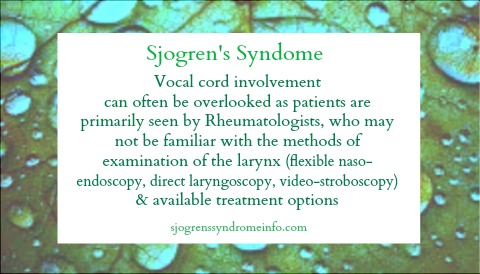How to protect your voice
People with Sjögren's can develop hoarseness if their vocal cords become inflamed as part of the disease or become irritated from throat dryness or coughing. However laryngeal involvement in Sjögren’s syndrome is not very common.
Vocal cord involvement can often be overlooked as patients are primarily seen by Rheumatologists, who may not be familiar with the methods of examination of the larynx (flexible naso-endoscopy, direct laryngoscopy, video-stroboscopy) and the available treatment options.
On the other hand Ear Nose and Throat (ENT) surgeons may not fully understand connective tissue disorders such as Sjögren's and the impact that it may have on the respiratory system.
The toxicity of some of the administered drugs in patients with Sjögren's can also make patient management even more challenging.
ENT involvement in the assessment and treatment of patients with Sjögren's, as part of a multidisciplinary approach, is necessary to ensure appropriate patient management when laryngeal manifestations are present.
Laryngeal* problems may include crico-arytenoid arthritis and laryngeal scarring, nodules in the vocal cords, or oedema of the ventricular folds.
To prevent further strain on your vocal cords, try not to clear your throat before speaking. Instead, take a sip of water, chew gum, or suck on candy. Or else make an "h" sound, hum, or laugh to gently bring the vocal cords together so you can get sound out. Clearing your throat does the same thing, but it's hard on the vocal cords, and you want to avoid irritating them further.
Possible symptoms of cricoarytenoid arthritis
- Hoarseness / laryngitis
- Painful swallowing (odynophagia)
- Feeling of a foreign object / lump in the throat (globus pharyngeus)
- Sore throat
- Cough
- Difficulty breathing (dyspnea)
- Change in sound or tone of voice (dysphonia)
- Loss of voice (aphonia)
- Pain during speaking
- Pain during swallowing (dysphagia)
- Choking sensation
- Stridor (high pitched sound caused by difficulty breathing)
* laryngeal means (of a speech sound) made in the larynx with only the front part of the vocal cords vibrating, giving a very low frequency and producing what is known as ‘creaky voice’.
RESOURCES:
Laryngeal Involvement in Connective Tissue Disorders. Is it Important for Patient Management? Emily Iacovou, Petros V. Vlastarakos, and Thomas P. Nikolopoulos Published online Indian J Otolaryngol Head Neck Surg. 2014 Jan; 66 (Suppl 1): 22 –. PMC
Rheumatoid Arthritis Warrior for Possible symptoms of cricoarytenoid arthritis

